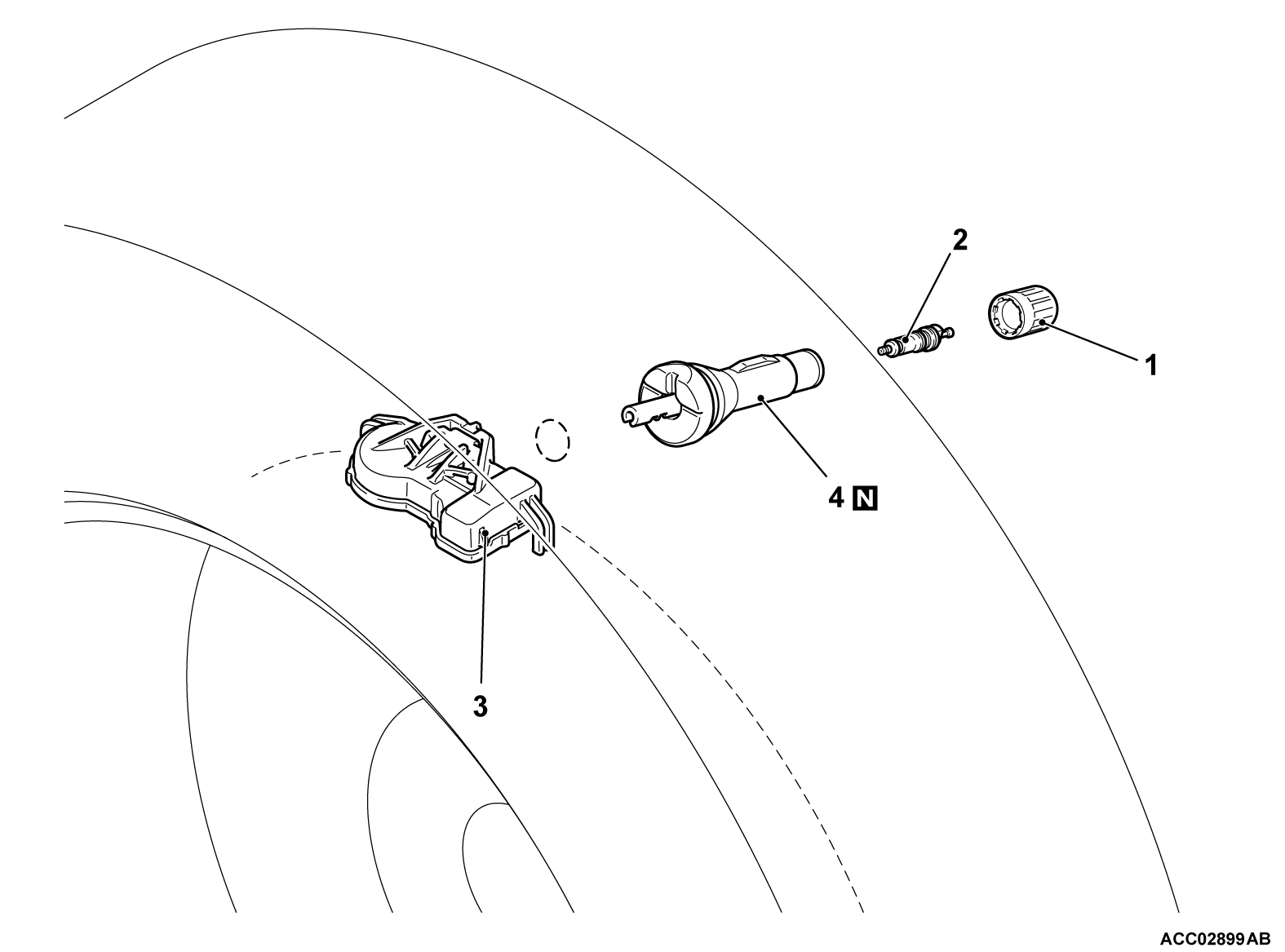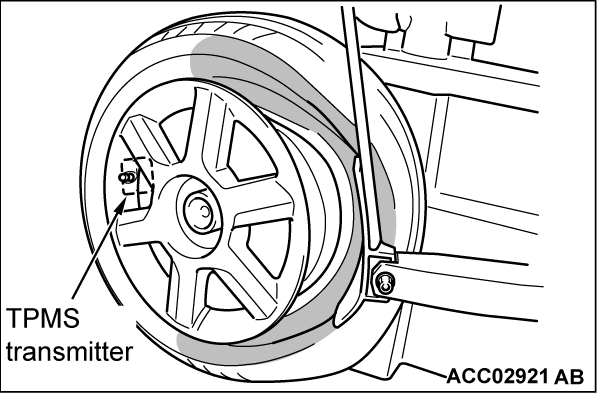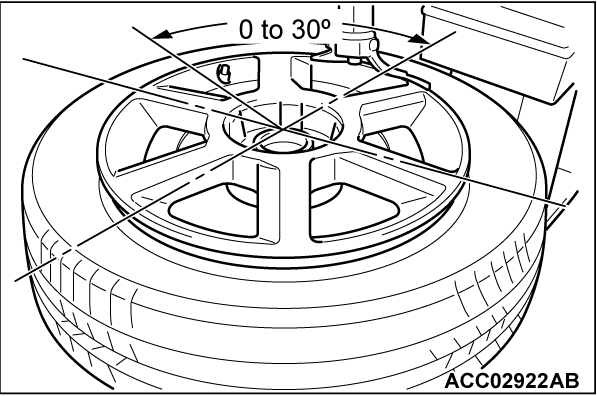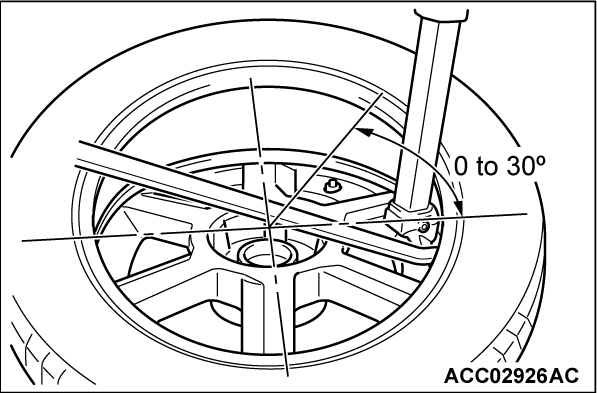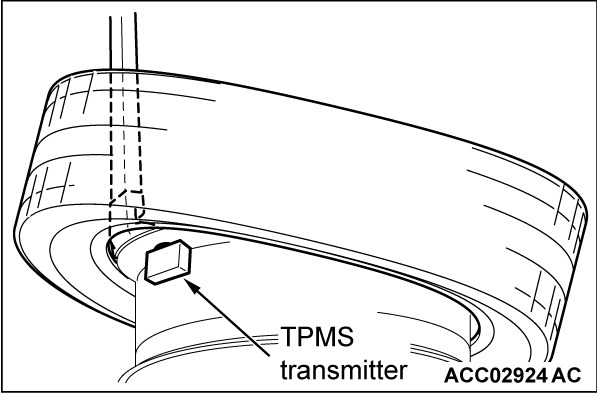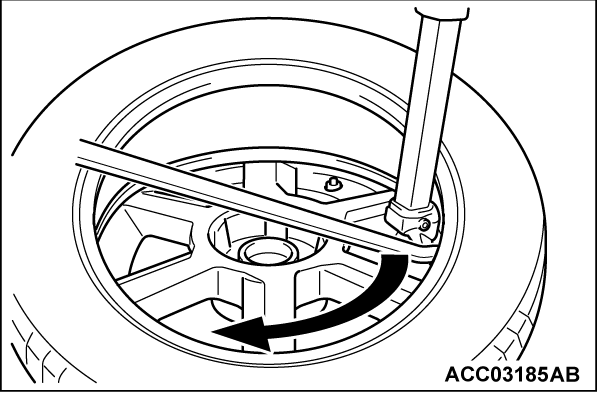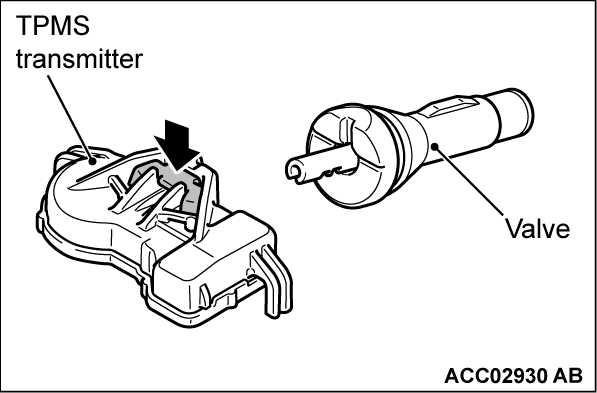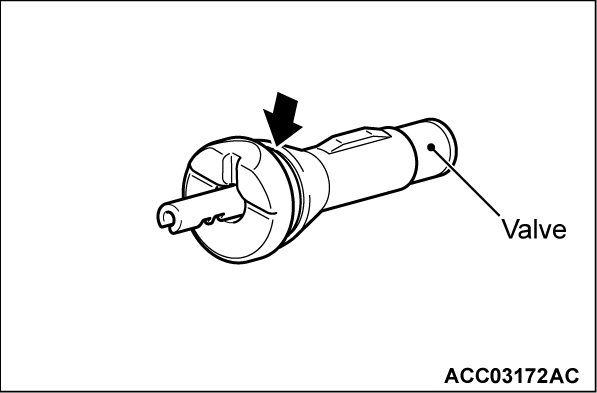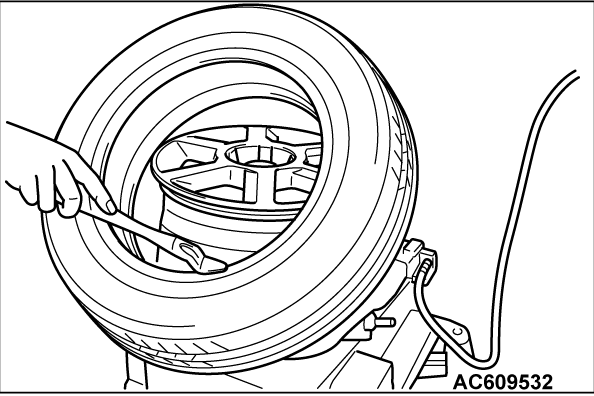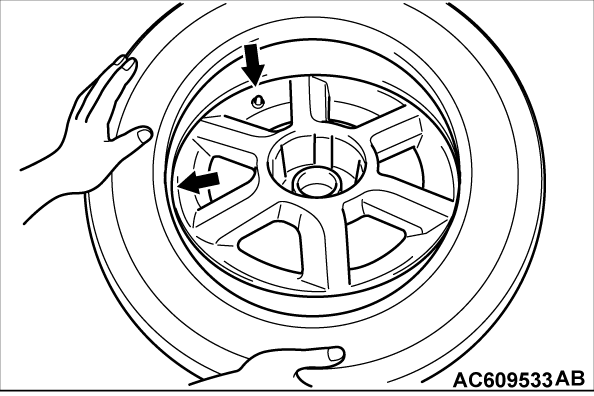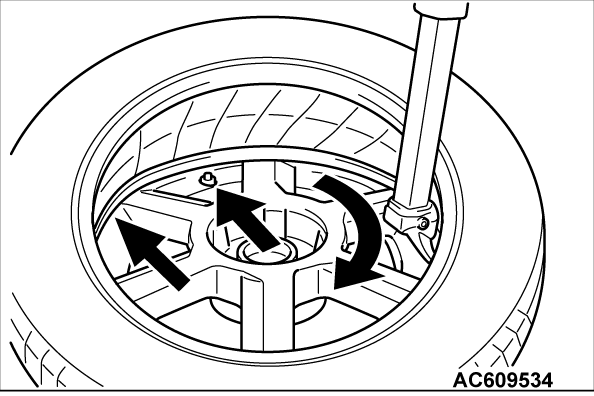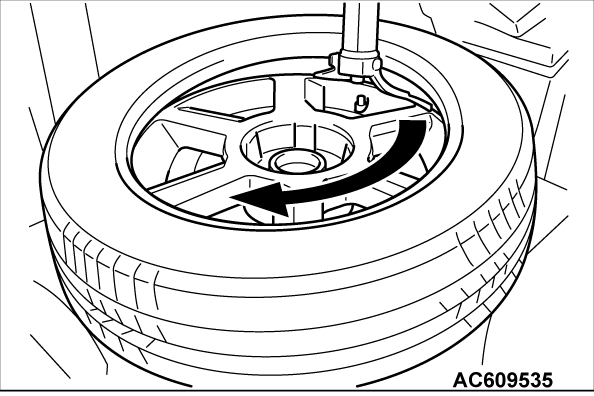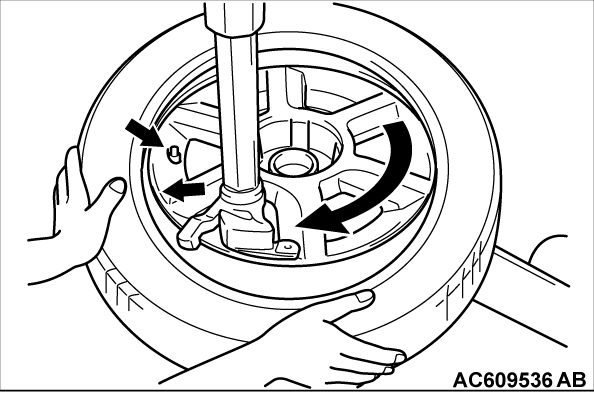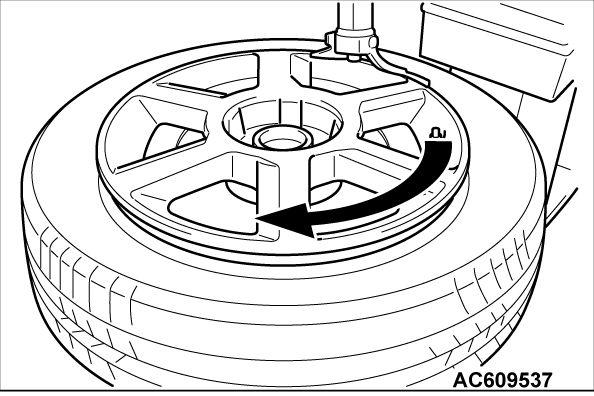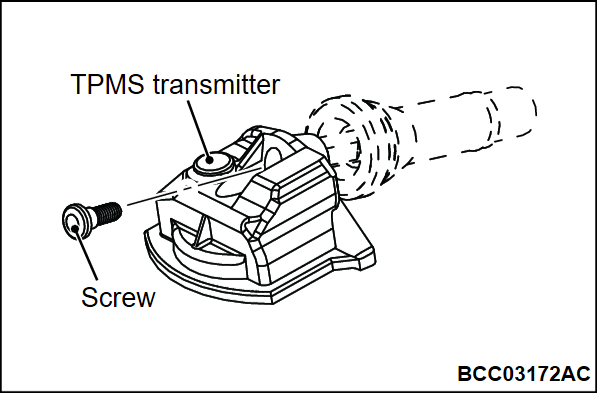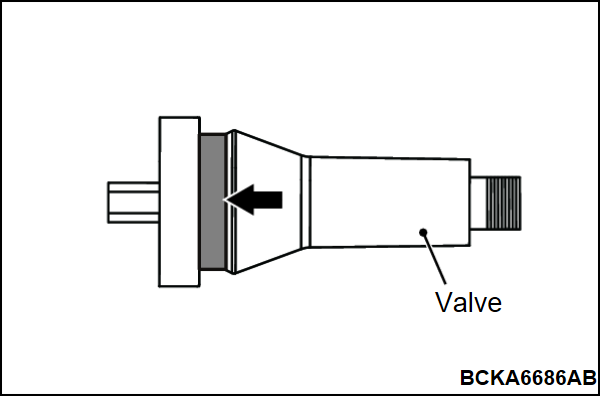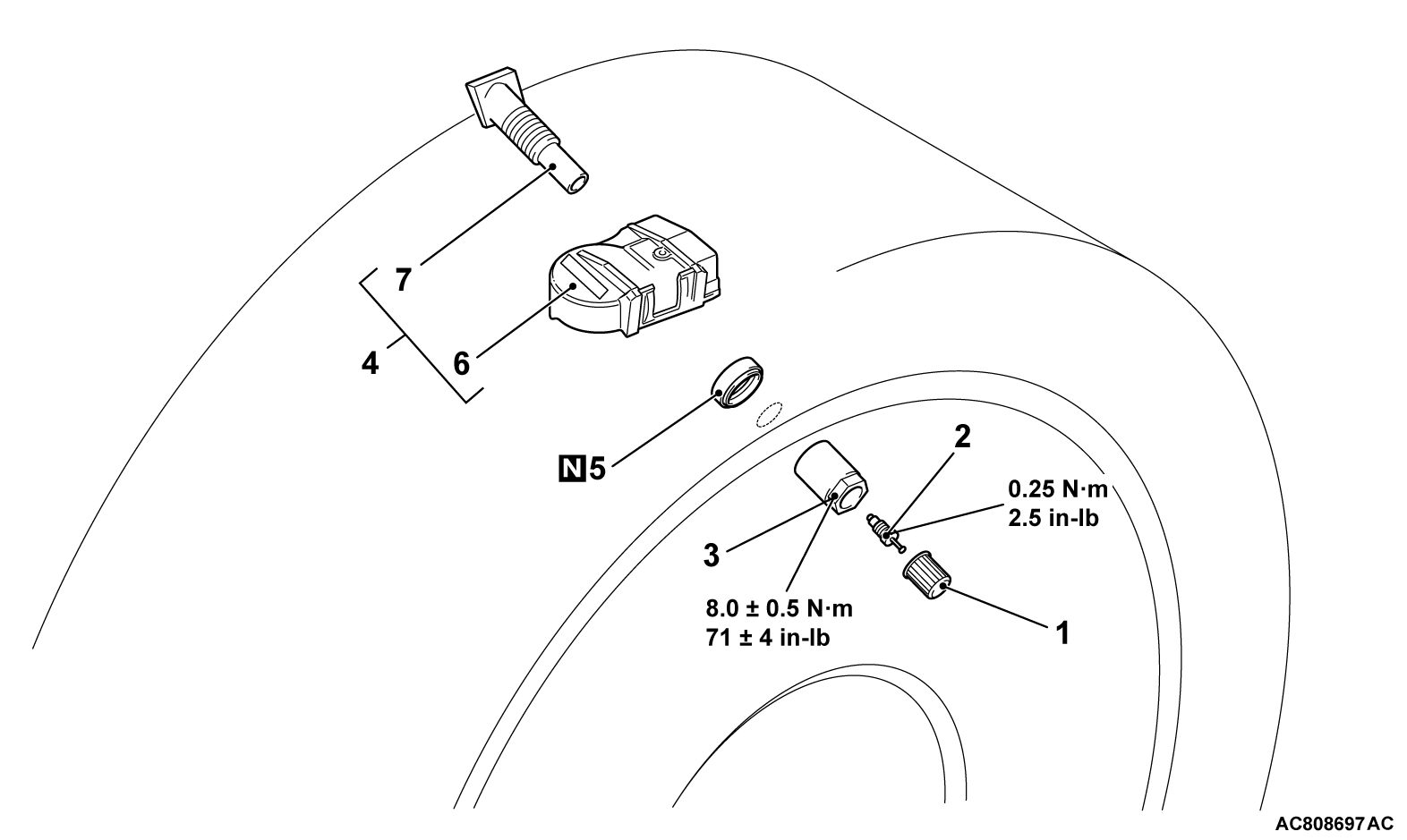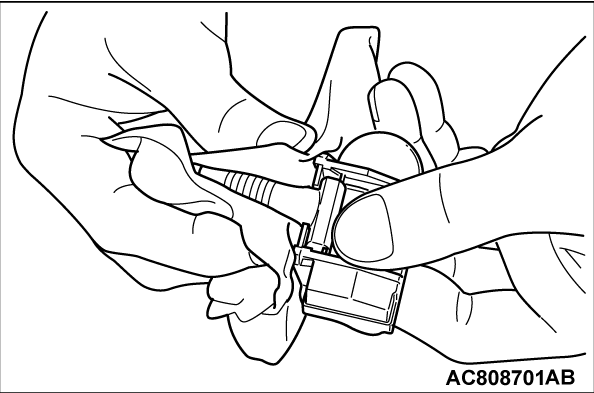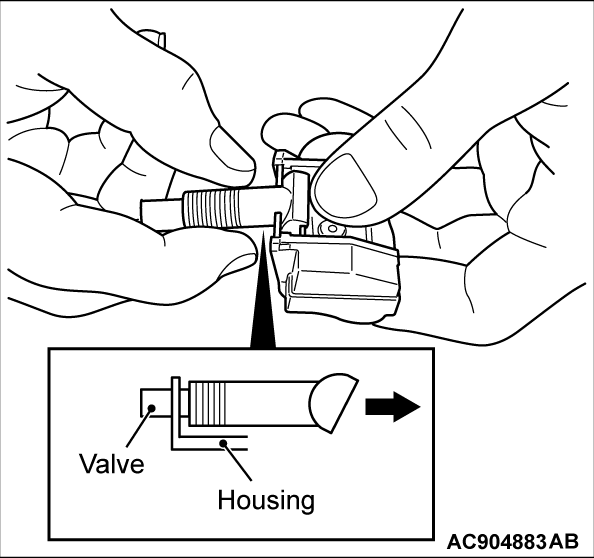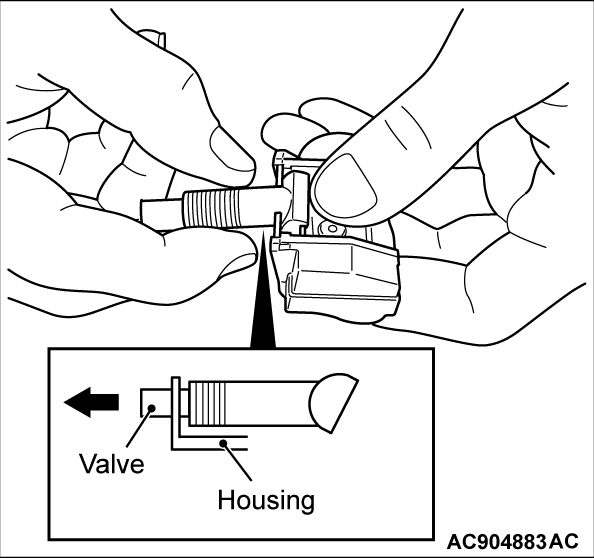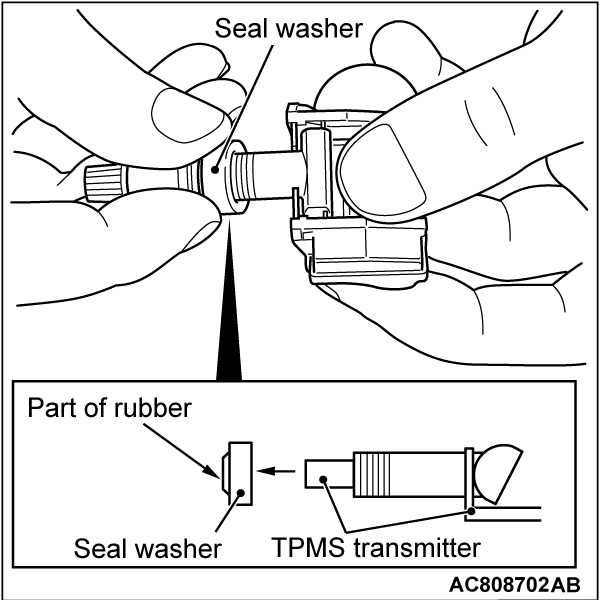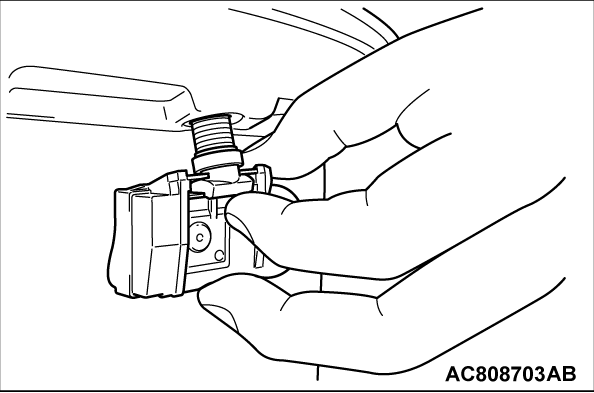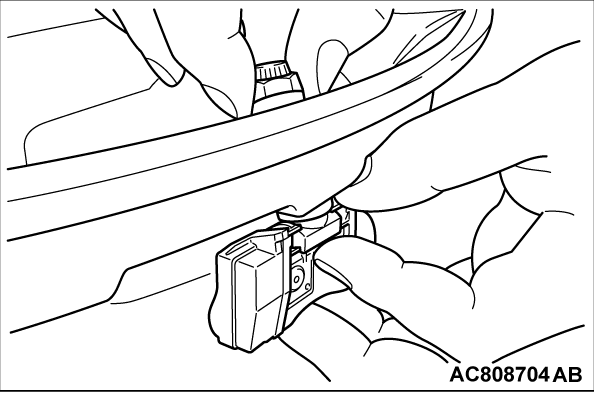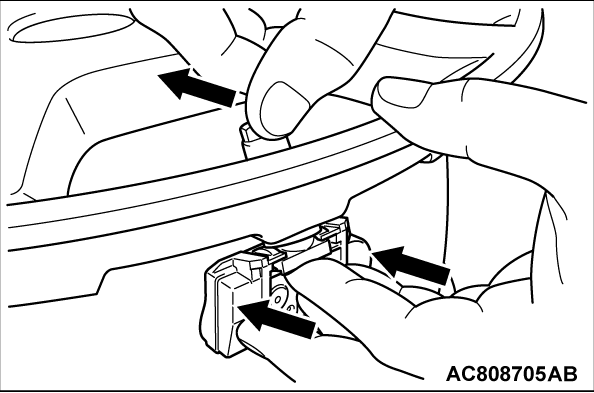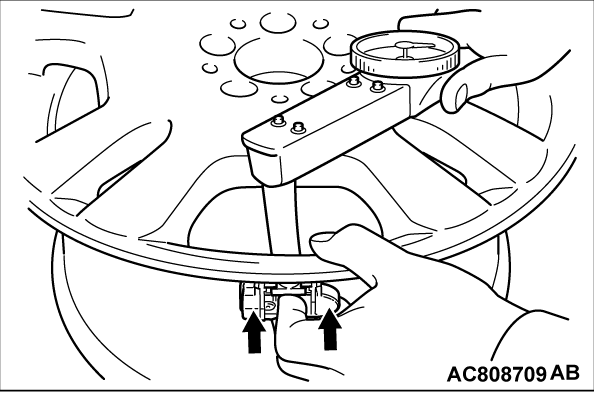REMOVAL AND INSTALLATION
<Vehicles with aluminum wheel>
| warning | Certain components of this vehicle, such as TPMS sensors may contain perchlorate materials. Before deployment and/or disposal of these components, review and comply with all applicable Federal, state and local regulations. |
| caution |
|
Pre-removal Operation
|
<Up to 2020 August>
REMOVAL SERVICE POINT
<<A>> TPMS TRANSMITTER REMOVAL
| caution | Be careful not to damage the TPMS transmitter. |
1. Fix the tire on a tire changing machine. Then apply a bead breaking shoe to the shown range to disengage the tire bead from the wheel rim.
| note | For the opposite side, repeat the same procedure. |
2. Fix the tire on a tire changing machine so that the TPMS transmitter is positioned as shown.
3.
Use a tire lever to disengage the upper bead.
| caution | Do not allow any impact or shock to the TPMS transmitter with a tire lever or tire bead. |
4. Rotate the tire in the direction of arrow to disengage the tire bead from the wheel.
5. Fix the tire on a tire changing machine so that the TPMS transmitter is positioned as shown.
6.
Use a tire lever to disengage the lower bead.
| caution | Do not allow any impact or shock to the TPMS transmitter with a tire lever or tire bead. |
7. Rotate the tire in the direction of arrow to disengage the tire bead from the wheel.
8.
Remove the TPMS transmitter from the valve while depressing the portion indicated by the arrow.
| caution | Do not attempt to remove the TPMS transmitter without depressing the portion indicated by the arrow. |
9. Cut down the entire groove shown by the arrow to remove the valve.
INSTALLATION SERVICE POINTS
>>A<< VALVE INSTALLATION
1.
The projection shown by the arrow should face towards the outside of the wheel.
| caution | Install only the valve to wheel at first. |
>>B<< TPMS TRANSMITTER INSTALLATION
1.
Install the TPMS transmitter into the valve while depressing the portion indicated by the arrow.
| caution | Do not attempt to install the TPMS transmitter without depressing the portion indicated by the arrow. |
2.
| caution | Make sure that the TPMS transmitter and the valve are installed securely. |
Pull the TPMS transmitter from the valve by hand to make sure it is secure.
| note | If the TPMS transmitter is disconnected from the valve, the tab securing the TPMS transmitter to the valve may be broken. |
>>C<< TIRE BEAD MOUNTING
1. Prepare the tire and fix the rim as usual.
2. Put the tire on the rim, so that the cross point of the bead with the rim is approximately 20 cm (7.9 inch) away from the valve.
3. Engage the shoe and make sure that 20 cm (7.9 inch) is maintained between the cross point and the valve.The arrow shows the direction of rotation of the wheel.
4. Turn the wheel in order to engage all the first side of the tire.
| note | The standard shoes can pass over the sensor without damaging it. |
5. Put the second side of the tire in position, so that the cross point of the bead with the rim is approximately 20 cm (7.9 inch) away from the valve. The curved arrow shows the direction of rotation of the wheel.
6. Turn the wheel in order to engage all of the second side of the tire.
| note | The standard shoes can pass over the sensor without damaging it. |
<From 2020 September>
REMOVAL SERVICE POINT
<<A>> TPMS TRANSMITTER REMOVAL
| caution | Be careful not to damage the TPMS transmitter. |
1. Fix the tire on a tire changing machine. Then apply a bead breaking shoe to the shown range to disengage the tire bead from the wheel rim.
| note | For the opposite side, repeat the same procedure. |
2. Fix the tire on a tire changing machine so that the TPMS transmitter is positioned as shown.
3.
Use a tire lever to disengage the upper bead.
| caution | Do not allow any impact or shock to the TPMS transmitter with a tire lever or tire bead. |
4. Rotate the tire in the direction of arrow to disengage the tire bead from the wheel.
5. Fix the tire on a tire changing machine so that the TPMS transmitter is positioned as shown.
6.
Use a tire lever to disengage the lower bead.
| caution | Do not allow any impact or shock to the TPMS transmitter with a tire lever or tire bead. |
7. Rotate the tire in the direction of arrow to disengage the tire bead from the wheel.
INSTALLATION SERVICE POINTS
>>A<< TIRE BEAD MOUNTING
1. Prepare the tire and fix the rim as usual.
2. Put the tire on the rim, so that the cross point of the bead with the rim is approximately 20 cm (7.9 inch) away from the valve.
3. Engage the shoe and make sure that 20 cm (7.9 inch) is maintained between the cross point and the valve.The arrow shows the direction of rotation of the wheel.
4. Turn the wheel in order to engage all the first side of the tire.
| note | The standard shoes can pass over the sensor without damaging it. |
5. Put the second side of the tire in position, so that the cross point of the bead with the rim is approximately 20 cm (7.9 inch) away from the valve. The curved arrow shows the direction of rotation of the wheel.
6. Turn the wheel in order to engage all of the second side of the tire.
| note | The standard shoes can pass over the sensor without damaging it. |
<Vehicles with steel wheel>
| warning | Certain components of this vehicle, such as TPMS sensors may contain perchlorate materials. Before deployment and/or disposal of these components, review and comply with all applicable Federal, state and local regulations. |
| caution |
|
Pre-removal Operation
|
REMOVAL SERVICE POINTS
<<A>> CAP/VALVE CORE/NUT REMOVAL
1.
| caution | Ensure cap is always in place except when adjusting tire pressure. |
Remove the valve cap.
2. Rotate tire so that valve stem is in the 6 o’clock position.
3. Use a long-reach 17.2 mm (0.68 inch) socket to unscrew the valve nut a few turns. Slowly push valve stem into tire so that tire pressure is relieved.
4. Once tire pressure is released, remove nut and let TPMS transmitter fall into tire.
<<B>> TPMS TRANSMITTER REMOVAL
| caution | Be careful not to damage the TPMS transmitter. |
1. Fix the tire on a tire changing machine. Then apply a bead breaking shoe to the shown range to disengage the tire bead from the wheel rim.
| note | For the opposite side, repeat the same procedure. |
2. Fix the tire on a tire changing machine so that the TPMS transmitter is positioned as shown.
3.
Use a tire lever to disengage the upper bead.
| caution | Do not allow any impact or shock to the TPMS transmitter with a tire lever or tire bead. |
4. Rotate the tire in the direction of arrow to disengage the tire bead from the wheel.
5. Fix the tire on a tire changing machine so that the TPMS transmitter is positioned as shown.
6.
Use a tire lever to disengage the lower bead.
| caution | Do not allow any impact or shock to the TPMS transmitter with a tire lever or tire bead. |
7. Rotate the tire in the direction of arrow to disengage the tire bead from the wheel.
<<C>> SEAL WASHER/VALVE REMOVAL
| caution |
|
1. Hold the TPMS transmitter and the seal washer, then extract the seal washer. Take care to not damage the valve thread.
2. Clean the TPMS transmitter and the valve stem. <In case of not removing the valve>
| note | If the valve comes out from transmitter, install it to where it was. (This is not failure) |
3. Removal the valve from housing as shown.
INSTALLATION SERVICE POINTS
>>A<< VALVE/SEAL WASHER/TPMS TRANSMITTER/NUT INSTALLATION
| caution |
|
1. Install the valve to housing as shown.
2. Insert the seal washer up to the base of the TPMS transmitter, making sure to secure the valve base with a thumb as shown.Wipe the seal and threading.
3.
Install the valve, in the valve hole, without modifying the angle of the stem (retain position of delivery). The laser marking should be visible at the operator.
| caution |
|
4. When the valve is completely inserted, maintain the TPMS transmitter in contact with the rim, then screw manually the nut until the contact with the wheel.
5. While maintaining the TPMS transmitter contact with the rim by applying pressure to the back of the valve, slightly press on the cap to wards the center of the wheel in order to adapt the angle of the valve/TPMS transmitter to the profile of the rim.It is mandatory to guarantee the contact of the housing unit on the rim drop center.
6. While maintaining the TPMS transmitter and valve in position, screw the nut with a torque wrench.Take care that the wrench socket is correctly inserted on the nut.
Specified torque: 8.0 ± 0.5 N·m (71 ± 4 in-lb)
>>B<< TIRE BEAD MOUNTING
1. Prepare the tire and fix the rim as usual.
2. Put the tire on the rim, so that the cross point of the belt with the rim is approximately 20 cm (7.9 inch) away from the valve.
3. Engage the shoe and make sure that 20 cm (7.9 inch) is maintained between the cross point and the valve.The arrow shows the direction of rotation of the wheel.
4. Turn the wheel in order to engage all the first side of the tire.
| note | The standard shoes can pass over the sensor without damaging it. |
5. Put the second side of the tire in position, so that the cross point of the belt with the rim is approximately 20 cm (7.9 inch) away from the valve. The curved arrow shows the direction of rotation of the wheel.
6. Turn the wheel in order to engage all of the second side of the tire.
| note | The standard shoes can pass over the sensor without damaging it. |
>>C<< TIRE PRESSURE INFLATION/NUT RETIGHTENING
| caution | After tire inflation, retighten the valve nut to 8.0 ± 0.5 N·m (71 ± 4 in-lb). This is necessary, because the TPMS transmitter is secured to the wheel with the valve nut and rubber grommet. The rubber grommet will be depressed by tire pressure or deteriorate over a period of time, which requires the valve nut to be retightened. |
Inflate tire to required pressure, then retorque the valve nut to 8.0 ± 0.5 N·m (71 ± 4 in-lb).
![[Previous]](../../../buttons/fprev.png)
![[Next]](../../../buttons/fnext.png)

